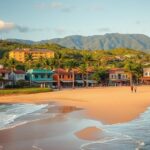Best way to meet Costa Rica rentista visa income requirements

Costa Rica has become a haven for individuals and families seeking a better quality of life, with its lush landscapes, pleasant climate, and rich cultural heritage. As a result, the number of Americans calling Costa Rica home has grown by 14% annually since 2020, reaching nearly 70,000.
For those seeking residency, Costa Rica offers various options, including the Rentista program, designed for individuals with stable and sufficient income. Understanding the residency options and their requirements is crucial for a smooth transition to life in this Central American paradise.
We will explore the most effective strategies for meeting the income requirements for a Rentista visa, providing a comprehensive guide for those seeking residency in Costa Rica.
Understanding the Costa Rica Rentista Visa

The Rentista Visa in Costa Rica is designed for individuals who have a steady income and wish to live in the country without being employed locally. This visa category is part of Costa Rica's residency options, catering to those who are not yet retired but have a stable financial background.
What is the Rentista Residency Program?
The Rentista residency program is a pathway for individuals with a guaranteed monthly income or sufficient savings to support themselves in Costa Rica. Unlike other residency programs such as Pensionado for retirees or Inversionista for investors, the Rentista program is ideal for those who are not retired but have the financial means to live in Costa Rica. This program allows applicants to include their spouse and dependent children under 25 in their application.
Benefits of Choosing the Rentista Visa Option
Choosing the Rentista Visa offers several benefits, including the ability to legally reside in Costa Rica and a straightforward path to permanent residency after just three years, and eventually to Costa Rican citizenship after seven years of residency. While on temporary Rentista status, holders cannot work as employees in Costa Rica, but they are allowed to own businesses and receive dividends. This makes the Rentista program particularly attractive for digital nomads, freelancers, and those with passive income sources who wish to enjoy Costa Rica's high quality of life.
Financial Requirements for the Rentista Visa

The Rentista residency program in Costa Rica has two primary financial pathways for qualification. To qualify for the Rentista Visa, applicants must demonstrate their ability to support themselves financially without working locally.
The $2,500 Monthly Income Method
One way to qualify is by proving a guaranteed monthly income of at least $2,500 USD. This income must be stable and guaranteed for at least two years, and can come from various sources such as investments, rental properties, or other passive income streams. Official documentation from financial institutions is required to verify these sources.
The $60,000 Bank Deposit Method
The alternative is to deposit $60,000 USD into a Costa Rican bank account and arrange for monthly withdrawals of $2,500 over a 24-month period. Although the full amount remains the applicant's property, it serves as a guarantee of income during the initial residency period. After two years, applicants must demonstrate continued financial solvency for renewal, regardless of the method initially chosen.
Both methods require careful documentation and proof of financial stability. Understanding these requirements is crucial for a successful Rentista Visa application in Costa Rica.
Best Way to Meet Costa Rica Rentista Visa Income Requirements

When it comes to meeting the Costa Rica Rentista visa income requirements, applicants have two distinct paths to choose from. The Rentista program is designed for individuals with a steady passive income who aren't yet retired, offering a unique opportunity for those with significant income from investments, rental properties, or other steady sources.
Comparing Both Income Requirement Options
The Costa Rica Rentista visa offers two primary methods to satisfy the income requirements: proving a stable monthly income of at least $2,500 for two years or making a $60,000 bank deposit in a Costa Rican bank, from which you can withdraw $2,500 monthly. Each option has its advantages and disadvantages.
The monthly income method allows applicants to avoid transferring a large sum to Costa Rica but requires proving income stability for two years. On the other hand, the bank deposit method provides a clear qualification process but involves transferring $60,000 to a Costa Rican bank.
Choosing the Right Option for Your Situation
When deciding between the two income requirement options, it's crucial to consider factors such as income source stability, comfort with international banking, and long-term residency plans. For instance, if you have a stable income from a reliable source, the monthly income method might be more suitable. However, if you prefer a more straightforward qualification process, the bank deposit method could be the better choice.
For more information on visa options for entrepreneurs, you can visit https://www.jaroscr.com/costa-rica-visa-options-for-entrepreneurs/. Banking verification is a critical aspect of the Rentista application process, and understanding how to navigate this can significantly improve your chances of approval.
To increase the likelihood of a successful application, it's essential to prepare the strongest possible financial documentation. Working with knowledgeable legal assistance can help ensure that your application demonstrates compliance with the financial requirements in a way that satisfies Costa Rican authorities.
Essential Documentation for Your Rentista Application

To successfully navigate the Rentista application process, it's essential to understand the required documentation. The Costa Rican immigration authorities require a comprehensive set of documents to be submitted along with your application.
Required Personal Documents
When applying for a Rentista visa, you'll need to provide several personal documents. These include a valid passport with at least six months' validity, a birth certificate, and marriage or divorce certificates if applicable. Additionally, you'll need to obtain a criminal background check from each country you've lived in during the past three years.
It's crucial to ensure that all documents are properly authenticated. For countries part of the Hague Convention, this involves obtaining an apostille certification. For other countries, consular authentication is required.
Financial Documentation Requirements
The financial documentation requirements for a Rentista visa application vary depending on whether you're opting for the monthly income method or the bank deposit method. For the monthly income method, you'll need to provide proof of a minimum income of $2,500 per month. For the bank deposit method, you'll need to show a deposit of $60,000 in a Costa Rican bank account.
It's essential to ensure that your financial documents are accurate and comply with the requirements set by the Costa Rican immigration authorities. This includes providing bank statements and other financial records as necessary.
The Bank Reference Letter: A Critical Component

A bank reference letter is a vital component of your Costa Rica Rentista visa application, serving as primary proof of your financial stability. This document must be carefully prepared to meet the specific requirements set by Costa Rican immigration authorities.
Essential Elements of a Valid Bank Reference
To be considered valid, a bank reference letter must include several key elements. These are: official letterhead with the bank's logo, a recent date (issued within six months of your application), complete bank contact information, your full legal name as it appears on your passport, financial verification of either $2,500 monthly income for two years or a $60,000 deposit, an authorized signature from a bank manager or official, and proper authentication through notarization and apostille/legalization in your home country.
For applicants using the Monthly Income Only Method, the letter must explicitly state that you receive at least $2,500 USD monthly, guaranteed for at least two years.
Common Mistakes to Avoid with Bank References
Applicants often make mistakes that can delay or reject their application. Common errors include using outdated letters, omitting required information, and failing to properly authenticate the document. To avoid these issues, it's crucial to work closely with your bank, providing them with the necessary details and, if needed, a template to ensure compliance with Costa Rican requirements.
Additionally, if the bank reference letter is not in Spanish, an official Spanish translation is required. Using an official translator in Costa Rica is recommended to ensure accuracy and compliance.
Step-by-Step Application Process

Navigating the Costa Rica Rentista Visa application process can be complex, but breaking it down into manageable steps makes it more achievable. The residency application process involves several stages, each requiring attention to detail and patience.
Document Preparation and Authentication
Before arriving in Costa Rica, gather all required documents from your home country. This step is crucial as it lays the foundation for a smooth application process. You'll need to authenticate your documents, which may involve notarization and apostille, depending on your country's requirements. Ensuring that your documents are in order will prevent delays in your application.
Submission and Follow-up Procedures
Once your documents are ready, you'll submit your application to Costa Rica's immigration office (Dirección General de Migración y Extranjería, or DGME). The submission process involves scheduling an appointment through the DGME website, paying the application fee at Banco de Costa Rica (approximately $50), and bringing all original documents and copies to your appointment. After submitting biometric data (fingerprints and photos), you'll receive your expediente (file) number for tracking purposes. Upon submission, you'll receive a comprobante (receipt) that serves as proof of your pending application, allowing you to remain legally in Costa Rica while your application is processed.
The waiting period after submission typically takes 3-12 months, depending on the residency category and current processing volumes. It's essential to follow up on your application status and be prepared to provide additional information if required by the immigration authorities.
Timeline and Costs for Obtaining Rentista Residency
To navigate the Rentista visa application successfully, it's essential to grasp the overall timeline and associated costs. The process involves several stages, each with its own timeframe and financial requirements.
Typical Processing Timeline
The current processing time for Rentista applications typically ranges from 6 to 10 months. This duration can be broken down into distinct phases: document gathering and authentication (1-3 months), application submission and initial processing (1 month), and application review and approval (4-8 months).
Complete Breakdown of Associated Costs
The costs associated with obtaining Rentista residency include government fees and other expenses. Official costs include application filing ($50), residency approval ($100), document certification ($30 per document), and DIMEX card issuance ($123). Additionally, there's the mandatory CAJA (Costa Rican healthcare system) enrollment, which costs between $60-300 monthly, depending on your declared income.
Other expenses to consider are attorney fees, which can range from $600 for basic assistance to $3,000+ for comprehensive services, and document preparation costs, including apostille services, translations, and shipping. Overall, applicants should budget between $3,000-$5,000 for the entire Rentista application process.
Including Family Members in Your Application
The Rentista visa program offers a significant advantage for families looking to relocate to Costa Rica together. One of the key benefits of this program is the ability to include immediate family members in your application, making it an excellent option for families.
Who Can Be Included as Dependents
Under the Rentista program, you can include your immediate family members as dependents. This includes your spouse or legal partner, regardless of age, and dependent children under 25 years of age who are financially dependent on you. In some cases, dependent parents may also be included. For more detailed information on family immigration, you can visit this guide on family immigration in Costa.
Additional Documentation for Family Members
When including family members in your application, you'll need to provide additional documentation. This includes a marriage certificate for your spouse, which must be apostilled or legalized, birth certificates for your children, also apostilled or legalized, and proof of dependency for children over 18, such as school enrollment documents. You'll also need to provide criminal background checks for dependents over 18 and passport copies for all dependents.
Life After Approval: Rights and Limitations
After obtaining Rentista residency in Costa Rica, you'll enjoy numerous benefits and face certain restrictions. As a temporary resident, you gain significant rights that enhance your living experience in Costa Rica.
What You Can and Cannot Do with Rentista Residency
With Rentista residency, you have the right to live long-term in Costa Rica, access the national healthcare system, open bank accounts, sign contracts, and own property with the same rights as citizens. However, there are limitations, particularly regarding work permissions. Rentista residents technically cannot work as employees in Costa Rica, though they can own businesses and receive investment income.
It's also important to note that you may need to request permission for extended travel outside Costa Rica and must maintain at least one day of physical presence in the country annually.
Tax Implications for Rentista Residents
Costa Rica's territorial tax system means that only income earned within the country is taxed. Foreign-earned income is generally not taxed, making Costa Rica attractive for those with international income sources. Property tax rates are approximately 0.25% of the assessed value, and a sales tax of 13% applies to most purchases.
It's crucial for Rentista residents, especially those from the United States, to comply with U.S. tax filing requirements, including potential benefits like the Foreign Earned Income Exclusion.
Path to Permanent Residency and Citizenship
Costa Rica's residency program is designed to be progressive, allowing you to transition from temporary to permanent residency and eventually to citizenship. This progression offers a clear path for individuals looking to make Costa Rica their long-term home.
Transitioning to Permanent Residency
After maintaining temporary Rentista residency for 3 years, you become eligible to apply for permanent residency. To maintain eligibility, it's crucial to renew your DIMEX card before expiration, remain current with CAJA payments, visit Costa Rica at least once a year if traveling abroad, and report any changes in income or status to immigration. For more detailed information on transitioning to permanent residency, you can visit this resource.
Requirements for Costa Rican Citizenship
Costa Rican citizenship becomes an option after 7 years of legal residency. To become a citizen, you'll need to pass a Spanish proficiency test and a civics exam. Citizenship offers numerous benefits, including the right to vote, hold a Costa Rican passport, and full participation in Costa Rican society. Additionally, Costa Rica allows dual citizenship, making it easier for individuals to maintain their original citizenship while becoming Costa Rican citizens.
Conclusion
In conclusion, Costa Rica's Rentista visa program offers a unique opportunity for individuals with stable income to achieve residency. The program provides two main financial options: proving a monthly income of $2,500 for two years or depositing $60,000 in a Costa Rican bank.
To increase the chances of approval, it's crucial to thoroughly prepare and document your application. The benefits of Rentista residency include the ability to include family members, access to healthcare, and a clear path to permanent residency after three years.
While Rentista status comes with work restrictions, these are removed upon obtaining permanent residency. We encourage you to assess your financial situation carefully and choose the income requirement option that best suits your circumstances.
For professional assistance with your Rentista visa application, you can contact Jaros CR at www.jaroscr.com, info@jaroscr.com, or +(506)7182-8969. With the right preparation, you can enjoy the rewarding lifestyle that Costa Rica offers, known for its natural beauty, stable democracy, and high quality of life.


